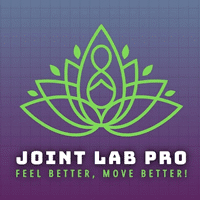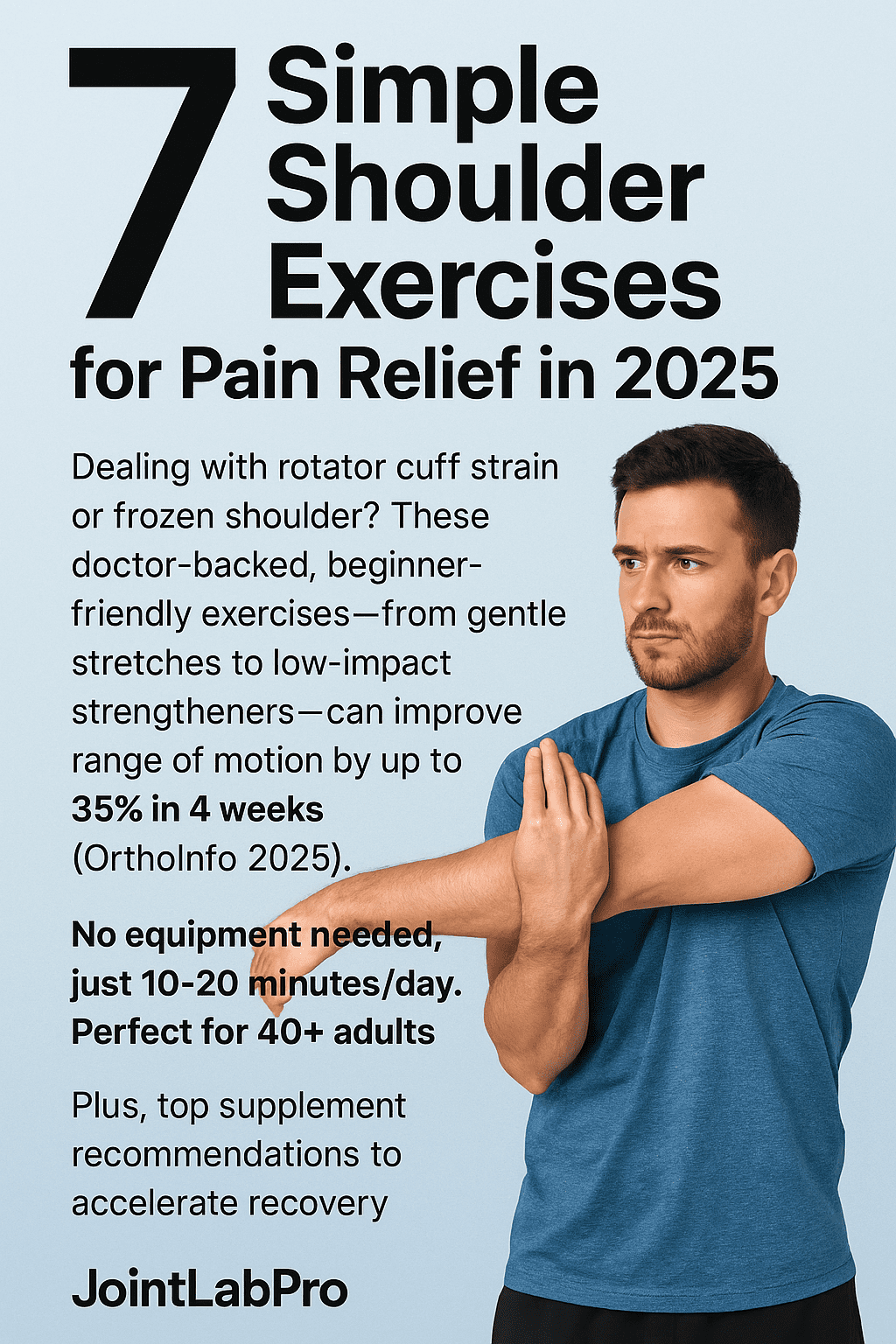7 Simple Shoulder Exercises for Pain Relief in 2025
Dealing with rotator cuff strain, frozen shoulder, or general stiffness?
These beginner-friendly shoulder exercises – from gentle mobility drills to low-impact strength moves –
are commonly used in rehab programs to help improve range of motion and reduce everyday discomfort over time.
You won’t need heavy equipment, just 10–20 minutes a day and consistency.
This guide is general information only and is not medical advice.
Always talk to your doctor or physiotherapist before starting new exercises,
especially if you have a diagnosed shoulder condition, recent injury, surgery,
or significant pain. Some links are affiliate links; we may earn a commission from qualifying purchases.
All opinions are independent.
Shoulder pain is extremely common in adults, whether from rotator cuff irritation,
frozen shoulder stages, posture issues, or repetitive overhead work.
Many orthopedic and physiotherapy programs use simple home exercises to gradually improve
mobility, strength, and control around the shoulder joint.
This beginner-focused guide walks through
7 shoulder exercises that are widely used in rehab:
you’ll see what they target, how to perform them safely, and how often to do them.
Start with around 10 minutes per day and build up slowly –
and stop if pain spikes or feels “sharp” rather than “stretchy”.
If you and your clinician decide supplements are appropriate,
some people also explore joint-support options like glucosamine or turmeric –
you’ll find links to in-depth reviews (for example, my
Doctor’s Best Glucosamine review)
alongside the exercise descriptions.
Exercise 1: Pendulum Swing (Gentle Mobility Starter)
The pendulum swing is often used early in rehab because it moves the shoulder joint
with very little load. The goal is to promote gentle motion and blood flow without
forcing the arm overhead or into painful positions – helpful in many cases of frozen shoulder
or after a flare-up, as long as your clinician has cleared you for movement.
- Stand leaning slightly forward, supporting yourself with your good arm on a table or chair.
- Let the affected arm hang loose like a pendulum.
- Gently swing the hanging arm forward and back 10–15 times.
- Then swing side to side 10–15 times, and in small circles 8–10 times each direction.
- Rest and repeat 1–2 sets if it feels comfortable.
Tip: Keep your shoulder relaxed; movement should feel easy and “swingy”, not forced. If your shoulder is very stiff or painful, start with fewer reps and smaller arcs of motion.
If you’re also exploring supplement support for general joint comfort,
you can read my
Arazo Nutrition Joint Support review
or
Doctor’s Best Glucosamine review
.
Exercise 2: Towel Stretch (Behind-the-Back Stretch)
The towel stretch works shoulder rotation behind your back,
a motion that often feels tight when rotator cuff tendons or capsule are irritated.
Go slow and stay well below your pain limit – you should feel a stretch, not a sharp pinch.
- Hold a towel or belt behind your back with your good arm above your shoulder and the affected arm behind your lower back.
- Use the top arm to gently pull the towel upward so the lower hand moves up your back until you feel a mild to moderate stretch.
- Hold 15–20 seconds, breathing steadily.
- Relax and repeat 3–4 times, then switch hand positions if comfortable.
Tip: Keep your neck relaxed and avoid jerking motions. If the stretch is too intense, use a longer towel and pull more gently.
For people interested in pairing stretching with general inflammation support,
some discuss turmeric/curcumin with their healthcare provider –
see my
BioSchwartz Turmeric review
for a deep dive into one such supplement.
Exercise 3: Side-Lying External Rotation (Rotator Cuff Strengthener)
This move targets the rotator cuff muscles that rotate your arm outward and help stabilize
the shoulder joint. It’s a classic physiotherapy exercise – but should be done with light resistance
and slow control, especially in the early stages.
- Lie on your non-painful side with the affected arm on top, elbow bent 90° and tucked to your side, forearm resting across your torso.
- Hold a very light weight (e.g., 0.5–1 kg dumbbell or water bottle) or start with no weight at all.
- Keeping the elbow glued to your side, slowly rotate your forearm upward toward the ceiling.
- Pause for 1–2 seconds, then lower back down with control.
- Aim for 8–12 reps, 2–3 sets, as tolerated.
Tip: If you feel pinching at the top of the movement, reduce the range or remove the weight. Form matters more than load.
If your clinician feels a joint-support supplement fits your case,
you can learn more about glucosamine + MSM combinations in my
Doctor’s Best Glucosamine review
.
Exercise 4: Sleeper Stretch (Internal Rotation Stretch)
The sleeper stretch focuses on internal rotation – another motion that often stiffens up
with shoulder issues. It can be very effective when done gently, but can also irritate some shoulders
if pushed too hard, so stay conservative and stop if pain feels sharp or pinchy.
- Lie on your affected side with the shoulder and elbow both at about 90°, arm in front of you.
- Use your other hand to gently press the forearm of the lower arm toward the floor until you feel a comfortable stretch in the back of the shoulder.
- Hold 15–20 seconds, then slowly release.
- Repeat 3–4 times, resting between holds.
Tip: If this position is too intense, place a small pillow or folded towel under your head and arm to reduce the angle. This should stay in the “good stretch” zone – not pain.
Exercise 5: Doorway Stretch (Chest & Front Shoulder Opener)
Many people with shoulder pain also have rounded shoulders and tight chest muscles from long hours at a desk.
The doorway stretch opens the front of the shoulders and chest gently, which can improve posture and reduce
some types of impingement-related discomfort.
- Stand in a doorway with your forearms on the door frame and elbows at about shoulder height.
- Step one foot forward and lean your body gently through the doorway until you feel a stretch across your chest and the front of your shoulders.
- Hold 15–30 seconds, keeping your shoulders down and away from your ears.
- Back out of the stretch slowly and repeat 2–3 times.
Tip: If the stretch feels too intense, lower your elbows slightly or step forward less. Keep your breathing slow and relaxed.
For people exploring anti-inflammatory support, curcumin with enhanced absorption is sometimes considered –
you can read more in my
BioSchwartz Turmeric review
.
Exercise 6: Band Pull-Aparts (Upper Back & Shoulder Blade Control)
Band pull-aparts help strengthen the muscles between your shoulder blades and the back of your shoulders,
improving posture and shoulder blade stability – key for healthy shoulder mechanics.
- Hold a light resistance band with both hands at shoulder height, arms straight in front of you.
- With soft elbows, gently pull the band apart, focusing on squeezing your shoulder blades together.
- Pause 1–2 seconds, then return to the start position with control.
- Aim for 10–15 reps, 2–3 sets, if you can do so without pain.
Tip: Start with a very light band and focus on quality of movement rather than force. Your neck should stay relaxed.
Exercise 7: Prone “Y” Raise (Scapular Stabilizer)
The prone “Y” raise targets the lower trapezius and other scapular stabilizers,
muscles that help your shoulder blade move smoothly when you lift your arm overhead.
- Lie face down on a mat or firm bed with your arms extended overhead in a “Y” shape, thumbs pointed up.
- Gently lift your arms a few centimeters off the surface, squeezing your shoulder blades down and together.
- Hold 2–3 seconds, then lower with control.
- Start with 8–10 reps for 1–2 sets, resting as needed.
Tip: Keep the move small and controlled. If your lower back or neck takes over, reduce the range or try the movement without lifting the arms as high.
Your 2025 Shoulder Pain Action Plan
A simple way to start:
- Week 1: 10 minutes per day – pick 2–3 gentle exercises (e.g., pendulum, doorway stretch, towel stretch).
- Week 2: Add 1–2 strength moves (e.g., side-lying external rotation, band pull-aparts).
- Week 3+: Build toward a 15–20 minute routine most days, as long as pain stays manageable.
Many people notice small improvements in comfort and mobility over 4–8 weeks when they stay consistent,
but progress is rarely perfectly linear. If pain worsens, becomes sharp, or starts to disturb your sleep more,
pause the routine and speak with a professional.
Final Thoughts: Build Stronger, More Comfortable Shoulders in 2025
These 7 shoulder exercises are based on movements commonly recommended in rehab for rotator cuff irritation,
frozen shoulder phases, and posture-related shoulder discomfort. Start slowly, stay within a tolerable range of
discomfort, and give your body time to adapt. The goal is gradual progress – not pushing through pain.
If you’re also considering joint-support supplements, you can explore my in-depth reviews:
Doctor’s Best Glucosamine (glucosamine + MSM focus)
and
Arazo Joint Support (glucosamine + chondroitin stack)
.
Always discuss supplements with your doctor, especially if you take medications or have existing diagnoses.
Check Doctor’s Best Glucosamine Review
View Arazo Joint Support Review
Or browse all my top-rated options in the
Best Joint Health Picks 2025 guide.

